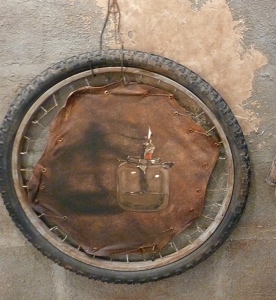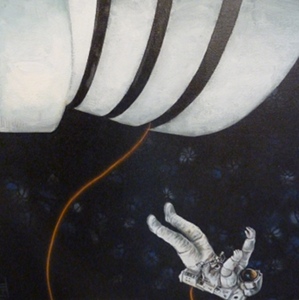Posted by Elena del Valle on June 18, 2010

Bicycle Tire by Julio Figueroa Beltrán
Photos: Accentmarketing
Driven by a former agency principal turned artist a Miami ad agency established Accent Alternative Art Space, a not-for-profit art initiative focused around real estate dedicated to non-commercially driven artwork by emerging and mid-career artists. Those behind the project hope it will foster “ideas that are outside of the mainstream scope of artists’ commercial galleries while harnessing local talent and culture.”
The mission of the project is to bring unknown, local talent to the forefront of the community’s art scene. Participating artists spend no monies to exhibit and receive all the proceeds of any sales, according to a project spokesperson. Killing and Salting, the premiere exhibit, opened last week featuring the work of seven local Cuban-American artists.

Astronaut by Julio Figueroa Beltrán
“There is so much unique art outside of the mainstream art scene that goes unnoticed,” said Esteban “Steve” Blanco, founding partner, Accentmarketing. “Our goal is to catapult these talented artists into the thick of it- no competition at all. In fact, we welcome all art galleries to come and pick up our featured artists.”
Blanco retired in 1993 and dedicated himself to art. When the warehouse adjacent to his art studio became available, he invested in the space to offer it to promising artists as a platform to build their work. According to an agency representative, artists of all creeds and races are encouraged to submit their work for consideration. Blanco will be the official decision maker on all artists to be selected for inclusion in exhibits. Agency executives hope the initiative will promote an artistic culture among its staff and contribute to Miami’s art scene.
“Accent Alternative Art Space is truly a passion project that is 110 percent committed to enriching Miami’s local art community as well as helping fellow artists,” said Diana Ocasio-Fant, executive vice president and creative director, Accentmarketing. “As an agency of creative individuals we want to reach out to the community regarding the importance of the arts, so this is a win-win for us because we can develop our own art while helping others do the same.”

Door Collage by Miguel Angel Báez
Accentmarketing, an ad agency based for 20 years in Coral Gables, a ritzy municipality in Miami, has painters, graphic art designers, creative writers, musicians and performing artists within the company ranks. Established in 1994, the Hispanic marketing communications agency has offices in Miami, Los Angeles and Detroit. Clients include the American Heart Association, Dunkin Donuts, Farmers Insurance, GobiernoUSA.gov, Chevrolet, the California Association of Realtors, Kaiser Permanente, Brown-Forman and the U.S. Navy.
Posted by Elena del Valle on August 24, 2009

Humane Society of Greater Miami Alley PSA campaign
Photos, video: Accentmarketing
There are 1.3 million cats and dogs in Miami-Dade County. While animal abuse and abandonment have been a problem for many years, with the recession and foreclosure glut the number of abandoned animals in that city has tripled, according to the Humane Society of Greater Miami. Organization representatives indicate that pet owners often don’t realize the implications of allowing their pets to breed, and the accompanying responsibility of finding homes for the whole litter.
In the hope of bringing attention to these issues, the Humane Society of Greater Miami with the support of Accentmarketing, unveiled a new $100,000 (estimated costs of production) Spanish language public service advertisement (PSA) campaign with Alley, a TV spot, and Studio Shot, a print ad. A radio ad is planned for release next month. They plan to distribute the ads to local Spanish language media. Scroll down to watch the video ad.
The TV ad features a lone baby dressed in a kitten costume crawling on the ground in a dark alley while a voice over discusses pet abandonment and sterilization issues on behalf of the Humane Society of Greater Miami Adopt-A-Pet program. As the camera pans out, viewers are meant to see that the baby represents an abandoned kitten, sitting by himself in a dirty and empty alley, lost and bewildered.
The spot creators want viewers to understand that just like babies, pets are part of their family. They want pet owners to realize that it’s their responsibility to spay and neuter their pets to help reduce the animal overpopulation problem in Miami-Dade County. To do that the Accentmarketing team focused on creating a strong correlation between how sterilizing a pet can result in saving thousands of animals from ending up homeless on the street or in a shelter.

Ana Maria Montero, account group director, Accentmarketing
“In this day and age where we see such unjust animal cruelty in our community, the Accentmarketing team felt passionate about instilling responsibility among current and future pet owners to spay and neuter their pets,” said Ana Maria Montero, account group director, Accentmarketing in a press release. “We are proud to be able to support the Humane Society of Greater Miami’s mission and contribute towards inspiring pet owners in our community to be more responsible for their pets.”
Studio Shot is a print interpretation of the Alley TV spot. The image of the baby wearing the kitten costume looks like a professional baby studio portrait. The headline reads: “Tu mascota es como un hijo. Sus crías también deberían serlo” (Spanish for Your pet is like your child. Their offspring should be as well.). The goal is to make pet owners see the baby like a pet, one of thousands of abandoned pets in the streets as a result of unsterilized pets. Most of those abandoned pets are likely to die, according to the organization.
The TV spot and print ad were shot in Los Angeles, where the Production House, D’Avant-Garde is located. Although the TV spot was shot in one day, pre-production and post-production of the TV and print ads required two months.
Twenty people donated their services pro bono to the Humane Society Spanish language PSA campaign. The Accentmarketing team members that led the campaign were: Luis Puerta, creative director and copywriter; Junior Jimenez, senior art director; Rudy Leschhorn, executive producer; and Ana Maria Montero. The following also supported the project: Pascui Rivas and Francisco Pugliese, media directors at D’Avant-Garde, Tom Marvel as director of photography, Guillermo Sauceda for the voice over, and digital retouching by Artistic Image.
The Humane Society of Greater Miami Adopt-A-Pet is a limited admit, adoption guarantee facility, dedicated to placing every dog and cat in their care into a loving home, and promoting responsible pet ownership and spay/neuter programs. Animals admitted into their shelter are safe from euthanasia for as long as it takes to find someone to adopt them. The organization houses 250 pets on a daily basis and spays or neuters 12,000 animals a year in its two clinics.
Established in 1994, Accentmarketing is a Hispanic marketing communications agency with offices in Miami, Los Angeles and Detroit. Clients include the American Heart Association, Farmers Insurance, GobiernoUSA.gov, Chevrolet, the California Association of Realtors, Kaiser Permanente, Brown-Forman and the U.S. Navy.
Posted by Elena del Valle on May 13, 2009

Heidi Richards Mooney, a Twitter fan
Twitter, an increasingly popular social networking site created because a man by the name of Jack Dorsey wanted to know what his friends were doing, is known best for the limited size of its posts. Funded initially by Obvious in San Francisco, California Twitter enthusiasts built and launched the first prototype in two weeks in March 2006. By August of that same year it opened to the public. Following rapid growth Twitter was incorporated May 2007.
What makes it special and popular? It seems to be, at least in part, the short postings and simple format. Visitors to the Twitter website find one question on their screen, “What are you doing?” Replies are limited to 140 characters or less. In order to participate and reply visitors must be subscribers to the service. They can send messages via mobile texting, instant message, and the web.
“Twitter is the world’s largest networking party! Where else can you meet anyone from world leaders to leaders of small companies, and learn and share? The give and take is what Twitter is all about,” said Heidi Richards Mooney, author, entrepreneur, and business coach, by email.
Twitter has been in the news lately because of a recent Nielsen study that indicates the booming portal is losing 60 percent of new subscribers each month. In other words, people stop using the service shortly after signing up. In reaching their conclusions, Nielsen analysts, according to an online article, took into account 30 Web sites and applications that feed into the Twitter community including TweetDeck, TwitPic, Twitstat, Hootsuite, EasyTweets, and Tumblr.
According to the Twitter website, the company “has many appealing opportunities for generating revenue but we are holding off on implementation for now because we don’t want to distract ourselves from the more important work at hand which is to create a compelling service and great user experience for millions of people around the world. While our business model is in a research phase, we spend more money than we make.”
Without a source of income and no advertising revenue can Twitter survive long term? Does it play a useful role? Should it survive? The company did not reply to several emails (there was no phone number listed in the contact page). While those who like Twitter find it valuable some people are saturated with social networking and can’t find the time for another task in their day. Others don’t see the usefulness of the short messages and prefer to rely on classic communication methods and traditional social networking sites.
“Twitter is one communication system too many for me! Between the radio, the web, FB, and Linkedin – I’m maxed out!” said a west coast radio host.

Claudia Miani, another Twitter enthusiast
“I use twitter professionally, from a PR perspective, to stay in touch with news producers and tweet stories to them when they are on the hunt for story ideas. I also follow several PR/ Social Media gurus’ tweets that lead to dozens of articles on the latest developments of social media, PR best practice cases, etc.,” said Claudia Miani, account supervisor at Accentmarketing in Coral Gables, Florida. “As a result of this, I am able to share learnings with my colleagues at Accentmarketing, clients and the industry which leads to an increase in followers each day. The key to growing the number of your followers is to keep updating relevant information on what you are passionate about.”
“Moving Beyond Traditional Media Measurement: measuring conversations and social media” audio recording

Presenter Katie Delahaye Paine, founder, KDPaine & Partners
Find out about
- Issues affecting online public relationships today
- Testing relationships as part of a survey
- Measuring ethnic group relationships
- Measuring foreign language communications in a similar ways to English
- Biggest challenges measuring conversations and social media
- Measuring online relationships with little or no money
Click here for information on “Moving Beyond Traditional Media Measurement”


















